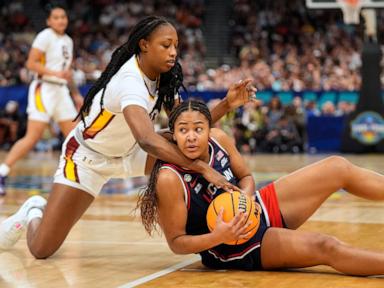
Courtroom 3 of California’s Oakland Courthouse, where a federal judge, Claudia Wilken, will hold Monday’s final hearing over a settlement in the landmark House v. NCAA lawsuit.
Assuming she signs off on the agreement in the coming hours, days or weeks, schools will be able to start paying players in every sport directly this year. Women’s basketball stands at a fascinating intersection at the dawn of the revenue-sharing era; it’s not a traditional cash cow like football or men’s basketball, but it’s more valuable than swimming or soccer. Women’s hoops is not generally a revenue-producing sport, with South Carolina coach Dawn Staley noting it’s “not there yet,” but the top collegians can make more than the top professionals.
Good luck figuring out how those forces and each school’s de facto $20.5 million salary cap will determine who cuts down the nets at next year’s Final Four in Phoenix and beyond.
“I think it’s going to affect a lot,” UCLA coach Cori Close said. “I don’t think we know how exactly.”
‘It will ruin parity’
UConn coach Geno Auriemma, unsurprisingly, was blunt about the impact he expects revenue-sharing to have on future tournaments.
“It will ruin parity. That’s No. 1,” Auriemma said.
Auriemma’s argument is easy to follow. When schools pay players directly, money will be an even bigger force in talent acquisition and retention. As the cost of success rises, fewer programs will be willing or able to pay it.
“So when you do those kind of things and it’s money-driven, it’s going to be, who is going to become the Dodgers and Yankees?” Auriemma said. “And how many of those are you going to have? And how many other programs in women’s basketball are going to be Milwaukee and Kansas City?”
Except the Brewers and the Royals aren’t competing for the same dollars as the Packers and Chiefs. At the college level, there’s the added layer of different sports at one school pulling from a shared pot.
The settlement does not detail how much each school must spend on each sport going forward, but most major programs are expected to share money similarly to the Georgia model: about 75 percent to football, 15 percent to men’s basketball, 5 percent to women’s basketball and 5 percent to everyone else. Close said she believes the Bruins’ brass will take care of her program, but she’s “nervous” about the big picture if different schools are less committed to her game.
“I’m lucky to be at a place where women’s basketball is really important,” Texas coach Vic Schaefer said. “But I’ll say this: I need football to be good.”
If it’s not, will a school’s powerbrokers divert more funds to make it good again? Or will an athletic department’s other programs suffer because the rising tide of football fails to lift everyone else?
The case for greater parity
If Auriemma’s prediction is on one end of the spectrum, Chiney Ogwumike’s thoughts are closer to the other. She envisions a path to greater parity in a sport that remains top-heavy.
If most schools use a similar revenue-sharing formula and have the same cap, that, in theory, should level the playing field in ...



